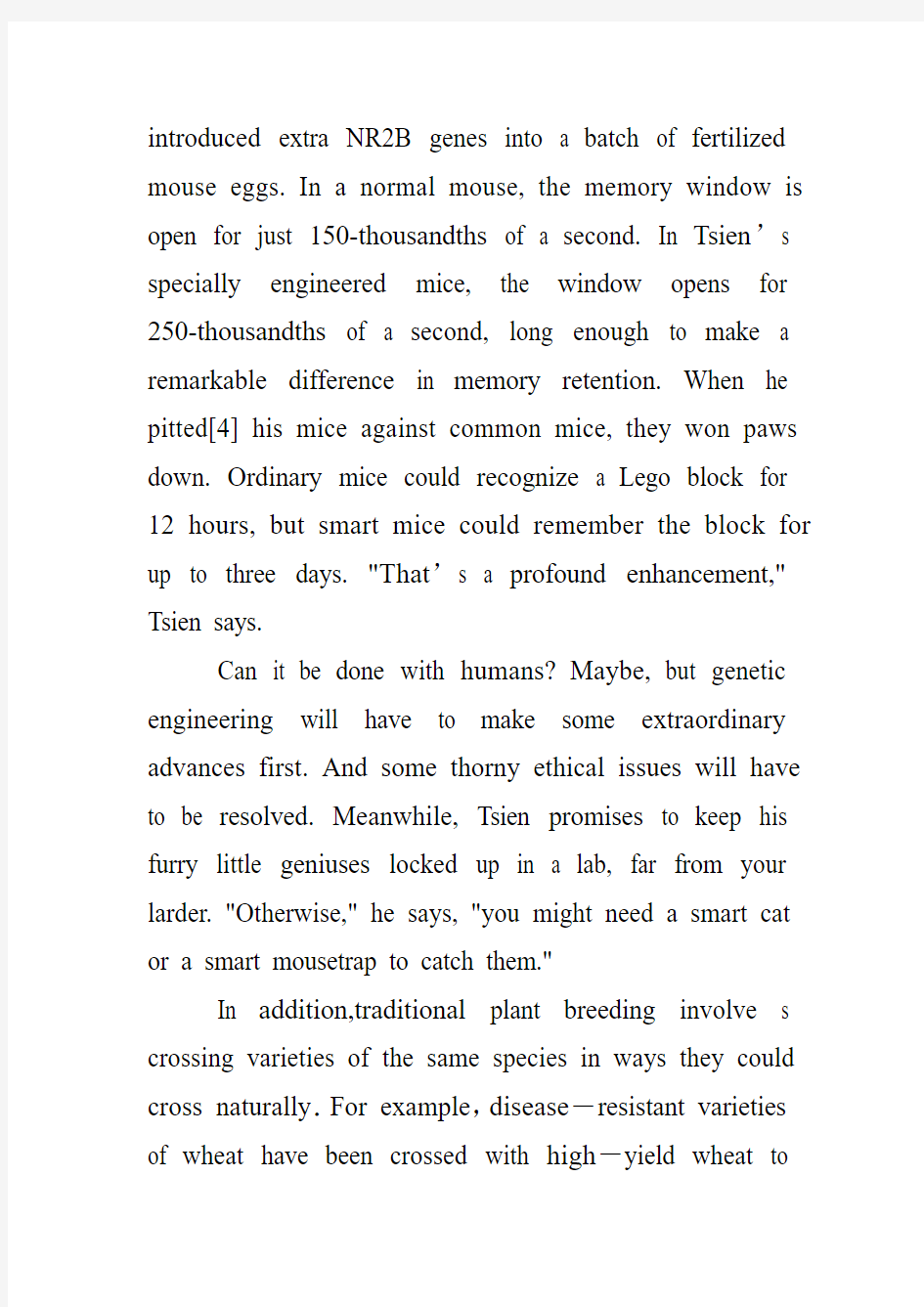Transgenosis


Transgenosis
When it comes to transgenosis there are many arguments,mainly in the following two aspects.
Firstly,many people dream of having a smarter brain. Princeton neurobiologist Joseph Z. Tsien found the key. In September he announced that he’d built a better mouse by altering a gene that affects learning and memory. A similar process of gene manipulation might conceivably be used one day to boost intelligence in humans.
The secret lies in a feature of brain cells called the nmda receptor, which Tsien likens[1] to a cylindrical tube or window that mediates[2] the flow of information. When the window is open, chemicals called neurotransmitters flow through easily and memory is registered and stored. But as organisms mature, the window begins to close. (This may explain why children lose their facility for learning new languages when they reach sexual maturity and why some people suffer memory loss as they age.)
Tsien noticed that the receptor worked more efficiently when teamed[3] with the gene NR2B, so he
introduced extra NR2B genes into a batch of fertilized mouse eggs. In a normal mouse, the memory window is open for just 150-thousandths of a second. In Tsien’s specially engineered mice, the window opens for 250-thousandths of a second, long enough to make a remarkable difference in memory retention. When he pitted[4] his mice against common mice, they won paws down. Ordinary mice could recognize a Lego block for 12 hours, but smart mice could remember the block for up to three days. "That’s a profound enhancement," Tsien says.
Can it be done with humans? Maybe, but genetic engineering will have to make some extraordinary advances first. And some thorny ethical issues will have to be resolved. Meanwhile, Tsien promises to keep his furry little geniuses locked up in a lab, far from your larder. "Otherwise," he says, "you might need a smart cat or a smart mousetrap to catch them."
In addition,traditional plant breeding involve s crossing varieties of the same species in ways they could cross naturally.For example,disease-resistant varieties of wheat have been crossed with high-yield wheat to
combine these properties.This type of natural gene exchange is safe and fairly predictable.
Genetic engineering(GE)involves exchanging genes between unrelated species that cannot naturally exchange genes with each other.GE can involve the exchange of genes between vastly different species――e.g.putting scorpion toxin genes into maize or fish antifreeze genes into tomatoes.It is possible that a scorpion toxin gene,even when it is in maize DNA,will still get the organism to produce scorpion toxin――but what other effects may it have in this alien environment?We are already seeing this problem――adding human growth hormone genes to pigs certainly makes them grow――but it also gives them arthritis and makes them cross-eyed,which was entirely unpredictable.
It will be obvious,for example,that the gene for human intelligence will not have the same effect if inserted into cabbage DNA as it had in human DNA――but what side-effect would it have?In other words,is GM food safe to eat?The answer is that nobody knows because long-term tests have not been carried out.
Companies wanting a GM product approved in the UK or USA are required to provide regulatory bodies with results of their own safety tests.Monsanto’s soya beans were apparently fed to fish for10weeks before being approved.There was no requirement for independent testing,for long-term testing,for testing on humans or testing for specific dangers to children or allergic people.
The current position of the UK Government is that“There is no evidence of long-term dangers from GM foods.”In the US,the American Food and Drug Administration is currently being prosecuted for covering up research that suggested possible risks from GM foods.
Time will prove everything.
